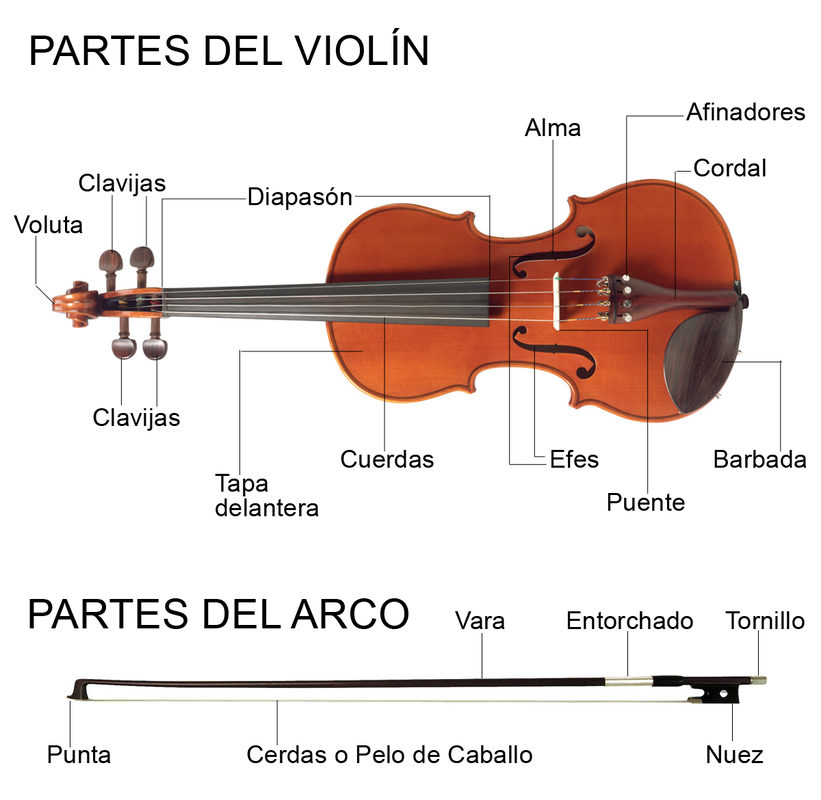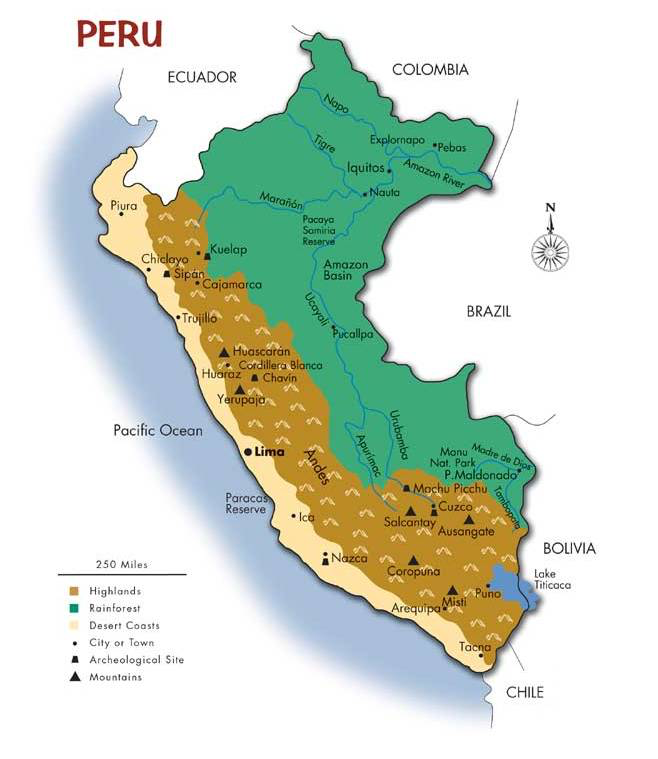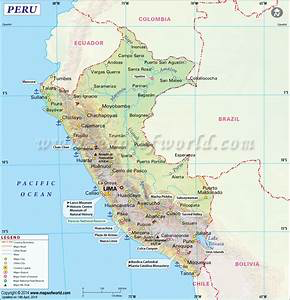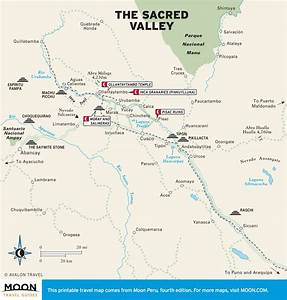PERU
- Official name: Republic of Peru (República del Perú; PE)
- Land area: 494,208 sq mi (1,279,999 sq km)
- Total area: 496,223 sq mi (1,285,220 sq km)
- Capital: Lima, 9.752 million (2015 est.)
- Other large city: Arequipa, 804,000
- Currency: Nuevo sol
- Telephone code: 51
- Electricity: 220V, 60Hz; plug/sockets A and C (Euro)
- National Holiday: Fiestas Patrias (7/28 and 7/29)
- Population: 31,036,656 (July 2017 est.)
- Population Change: Growth rate: 0.95%; 17.8 births/1,000 population, 6.1 deaths/1,000 population, -2.2 migrant(s)/1,000 population; infant mortality rate: 18.4 deaths/1,000 live births (2017 est.)
- Life Expectancy: 74 years
- Nationality/Demonym: Peruvian (Peruano/a)
- Languages: Spanish 84.1%, Quéchua 13%; Aymara 1.7% (all three official); many minor Amazonian languages
- Ethnicity/race: Amerindian 45%, mestizo 37%, white 15%, black, Japanese, Chinese, and other 3% (2007 est.)
- Religions: Roman Catholic 81.3%, Evangelical 12.5%, other 3.3%, unspecified or none 2.9% (2007 est.)
- Literacy rate: 94.2% (2016 est.)
- Geography: Peru, in western South America, extends for nearly 1,500 mi (2,414 km) along the Pacific Ocean. Colombia and Ecuador are to the north, Brazil and Bolivia to the east, and Chile to the south. Five-sixths the size of Alaska, Peru is divided by the Andes Mountains into three sharply differentiated zones. To the west is the coastline, much of it arid, extending 50 to 100 mi (80 to 160 km) inland. The mountain area, with peaks over 20,000 ft (6,096 m), lofty plateaus, and deep valleys, lies centrally. Beyond the mountains to the east is the heavily forested slope leading to the Amazonian plains.
Peru shares borders with five neighboring countries. In order of shared border length, these are: Bolivia (900 km), Brazil (1,560 km), Chile (160 km), Colombia (1,496 km), and Ecuador (1,420 km).
Economy
OverviewGDP/PPP: $424.6 billion (2017 est.)
Growth Rate: 2.7% (2017 est.)
Inflation: 3.2% (2017 est.)
Government Revenues: 28.4% of GDP (2017 est.)
Public Debt: 25.7% of GDP (2017 est.)
Labor Force
Working Population: 17.03 million (2017 est.)
Employment by Occupation: Agriculture: 25.8%, Industry: 17.4%, Services: 56.8% (2011 est.)
Unemployment: 6.7% (2017 est.)
Population Below the Poverty Line: 22.7% (2015 est.)
Trade
Total Exports: $42.47 billion (2017 est.)
Major Exports: Copper, gold, lead, zinc, tin, iron ore, molybdenum, silver; crude petroleum and petroleum products, natural gas; coffee, asparagus and other vegetables, fruit, apparel and textiles, fishmeal, fish, chemicals, fabricated metal products and machinery, and alloys.
Export Partners: China 23.5%, US 17.3%, Switzerland 7.1%, Canada 4.7% (2016)
Total Imports: $38.8 billion (2017 est.)
Major Imports: Petroleum and petroleum products, chemicals, plastics, machinery, vehicles, TV sets, power shovels, front-end loaders, telephones and telecommunication equipment, iron and steel, wheat, corn, soybean products, paper, cotton, and vaccines and medicines.
Import Partners: China 22.8%, US 20.2%, Brazil 5.8%, Mexico 4.5% (2016)
Products
Agricultural Products: Artichokes, asparagus, avocados, blueberries, coffee, cocoa, cotton, sugarcane, rice, potatoes, corn, plantains, grapes, oranges, pineapples, guavas, bananas, apples, lemons, pears, coca, tomatoes, mangoes, barley, medicinal plants, quinoa, palm oil, marigolds, onions, wheat, dry beans; poultry, beef, pork, dairy products; guinea pigs; fish.
Major Industries: Mining and refining of minerals; steel, metal fabrication; petroleum extraction and refining, natural gas and natural gas liquefaction; fishing and fish processing, cement, glass, textiles, clothing, food processing, beer, soft drinks, rubber, machinery, electrical machinery, chemicals, furniture.
Resources
Natural Resources: Copper, silver, gold, petroleum, timber, fish, iron ore, coal, phosphate, potash, hydropower, and natural gas.
Land Use: Agricultural land: 18.8% (arable land 3.1%; permanent crops 1.1%; permanent pasture 14.6%), Forest: 53%, Other: 28.2% (2011 est.)
CommunicationsTelephones
Fixed Lines: 3,074,464, 10 per 100 residents (2016 est.)
Cell Phones: 36,933,161, 119 per 100 residents, (2016 est.)
International Country Code: 51
Internet
Internet Country Code: .pe
Internet Users: 13,975,422, 45.5% (2016 est.)
Broadcast Media
10 major TV networks of which only one, Television Nacional de Peru, is state owned; multi-channel cable TV services are available; in excess of 2,000 radio stations including a substantial number of indigenous language stations (2010).
Transportation InfrastructureAirports
Total Airports: 191 (2013)
With Paved Runways: 59
With Unpaved Runways: 132
Registered Air Carriers: 7
Registered Aircraft: 35
Annual Passengers: 13,907,948
Railways
Total: 1,854.4 km
Standard Gauge: 1,730.4 km (1.435-m gauge)
Narrow Gauge: 124 km (0.914-m gauge)
Roads
Total: 140,672 km (includes 24,593 km of national roads (14,748 km paved), 24,235 km of departmental roads (2,340 km paved), and 91,844 km of local roads (1,611 km paved)
Waterways
Total: 8,808 km (8,600 km of navigable tributaries on the Amazon River system and 208 km on Lago Titicaca) (2011)
Ports and Terminals:
Major Seaport(s): Callao, Matarani, Paita
River Port(s): Iquitos, Pucallpa, Yurimaguas (Amazon)
Oil Terminal(s): Conchan oil terminal, La Pampilla oil terminal
Container Port(s) (TEUs): Callao (1,616,365)



